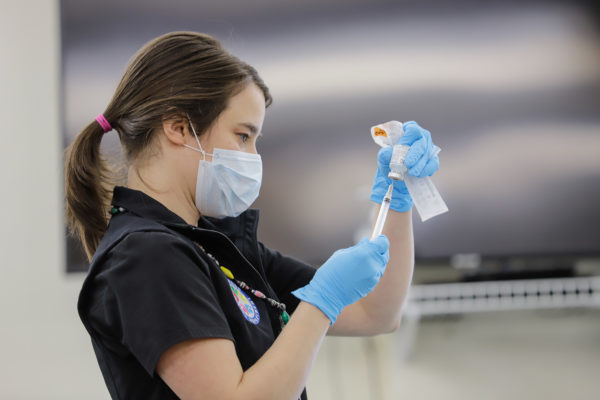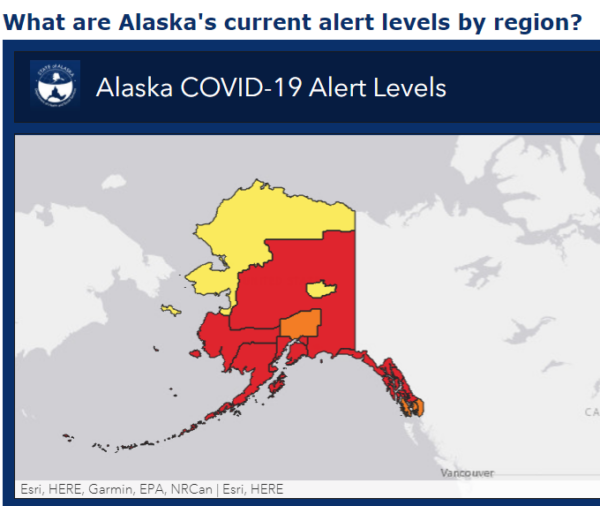
Alaska has joined a cohort of U.S. states where coronavirus cases and hospitalizations are rising rapidly.
Nearly every region in Alaska, including Anchorage, is back under a high-alert level based on their case rates — shown in red on the state health department’s map, Dr. Anne Zink, Alaska’s chief medical officer, said Thursday.
“Here’s where we’re at: More red, more orange, not where we want to be in the state,” Zink said on Thursday afternoon, during a call with reporters.

According to The New York Times on Thursday evening, Alaska, with a 283 percent jump, had the country’s fourth-highest increase in coronavirus cases over the past two weeks, behind Massachusetts, Washington, D.C., and Alabama. Alaska also ranked with the steepest rises in coronavirus-related hospitalizations over those 14 days.
Numbers are still much lower than Alaska’s surge in cases this winter, before the vaccine became widely available. But they’re going up.
[Sign up for Alaska Public Media’s daily newsletter to get our top stories delivered to your inbox.]
Health officials say the highly-contagious delta variant is largely driving the latest wave of infections, with nearly everyone sick not vaccinated against the coronavirus.
The case increases have prompted Juneau to resume gathering restrictions and mask requirements. They’ve also shuttered a seafood processing plant in Cordova and led to a mask mandate for city workers, reported the Anchorage Daily News.
Zink said the speed of the current rise in infections is similar to what Alaska saw in November. There’s no reason to think cases are peaking yet, she said. She’s watching infection rates soar in other states with similar vaccination rates to Alaska, including Missouri, Arkansas and Florida. She worries Alaska could be a few weeks behind them.
“So I think we have a chance to learn from these other states, and really encourage people to get vaccinated — like today,” Zink said. “We can learn from them. And we have a chance, but that window is narrowing quickly.”
For weeks, Alaska has wrestled with a stalled vaccination rate. Just 52% of eligible residents are fully vaccinated. Alaska has fallen from being one of the country’s highest-vaccinated states rates this spring, into the bottom half of the national rankings.
RELATED: Uptick in COVID-19 cases prompts new restrictions in Juneau
Meanwhile, a rise in coronavirus patients is also straining local hospitals, which are already trying to balance staffing shortages with the busier summer season, said Zink. Tourists and more people recreating outside generally leads to more hospitalizations this time of year.
It’s a concern at Providence Alaska Medical Center, said chief medical officer Dr. Michael Bernstein.
“We tend to run pretty full in the summer. And now if you add the surge onto it, really the biggest concern is just overall hospital capacity,” he said.
Bernstein said Providence has an average of about two dozen coronavirus patients in the hospital each day — up from five or six a month ago. He said, generally, the patients are younger now.
“We believe that’s probably because a higher percentage of the older population has been vaccinated,” he said.
Many are also very sick when they get to the hospital.
“Almost a quarter of our COVID patients are on ventilators, and about a third of them are in an ICU setting,” he said.
In a report on Thursday, the state health department said multiple hospitals in Anchorage were diverting patients this weekend “due to high volumes of both COVID and non-COVID patients.”
RELATED: Alaska returns to high alert as COVID-19 cases and hospitalizations climb
Zink said another metric health officials continue to watch closely is the percent of COVID-19 tests coming back positive. Over the past week, the average was 5.35%. And, 5% is generally considered “too high,” according to the Centers for Disease Control and Prevention.
“Once we get over 5%, it gets really concerning that we’re not testing enough people,” said Dr. Coleman Cutchins, the state’s COVID testing coordinator. “So really, a lot of our messaging is: Anyone with any symptom that could be COVID — vaccinated or not — you should get tested.”
Reach reporter Tegan Hanlon at thanlon@alaskapublic.org or 907-550-8447.
Tegan Hanlon is the digital managing editor at Alaska Public Media. Reach her at thanlon@alaskapublic.org or 907-550-8447. Read more about Tegan here.





